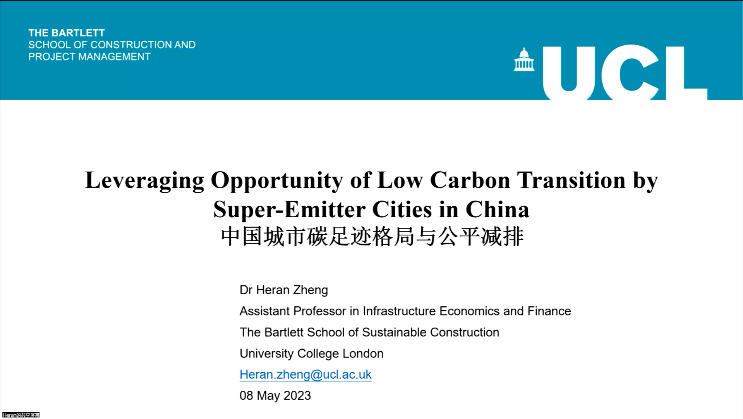At the invitation of the School of Management and Economics, Dr. Zheng Heran, assistant professor of the School of Sustainable Construction, Bartlett Department of Architecture, University College London, made an academic report entitled "China's Urban Carbon footprint Pattern and Fair Emission Reduction" online at 20pm on May 8, 2023. The lecture was hosted by Professor Li Hao, and many teachers and students from the college participated in the lecture.
Firstly, Professor Zheng Heran introduced that Chinese cities are the core of national carbon reduction and global decarbonization initiatives, but the gap between cities has become a major challenge in achieving this goal. Low carbon transformation should prioritize achieving fairness between cities and convergence of emission reduction goals. The interconnected supply chain of production and consumption between cities is a factor shaping inequality and promoting emission reduction development, but aggregation considerations are relatively few.
Then, Mr. Zheng Heran described his research results, that is, he simulated the supply chain of 309 Chinese cities in 2012 to quantify the Carbon footprint inequality, and explored the impact opportunities of achieving inclusive low-carbon transformation.
Furthermore, Mr. Zheng Heran revealed an important regional inequality in carbon emissions: the per capita Carbon footprint of the 10 richest cities in China is equivalent to that of the United States, while half of China's cities are lower than the global average. In China, the inter city supply chain involving 80% carbon emissions means a major risk of Carbon leakage and contributes to social and economic inequality. However, significant regional inequality in carbon emissions means there is a huge opportunity, with 32 super emitting cities being able to achieve significant emissions reductions.
Finally, Teacher Zheng Heran proposed an initiative. If super emitting cities implement differentiated emission reduction paths such as wealth, industrial structure, and supply chain roles, they can create a maximum carbon quota of 140 million tons and increase the expected carbon quota by 30% to the carbon peak. The additional carbon quota can enable the other 60% of Chinese people to achieve a middle-income or above living standard, highlighting the collaborative mechanism at the city level, and helping to achieve overall fairness and meet emission reduction standards.
After the report, the attending teachers and students had a positive discussion with Zheng Heran, which received a lot of inspiration. The report received a warm response and received unanimous praise from teachers and students.
Reported by:
Zheng Heran, Doctor of International Development, Assistant Professor of School of Sustainable Construction, Bartlett Department of Architecture, University College London. The research focuses on input-output simulation analysis, sustainable production and consumption, and is committed to quantifying the impact of public policies on social environmental spillovers through industrial chains. The relevant research results have been pu





